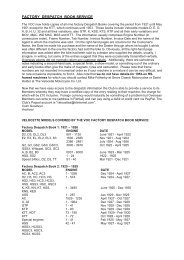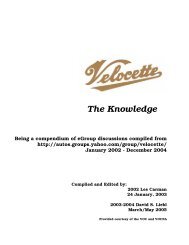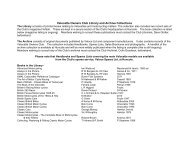The Knowledge - Velocette Owners Club
The Knowledge - Velocette Owners Club
The Knowledge - Velocette Owners Club
Create successful ePaper yourself
Turn your PDF publications into a flip-book with our unique Google optimized e-Paper software.
cables using modern Japanese clutch cable assy.s & they work really good if properly made up. All the<br />
above needs a thinking approach at every point, don't ignore even the smallest indication of lost<br />
movement.<br />
L #3653 I have a small bag with 88 clutch plate inserts (C25-2) that I bought from Lou Branch in<br />
Los Angeles in 1974 (?). Price marked on the bag is $11.44 :-) <strong>The</strong> material is not cork, looks like<br />
Ferodo and in great condition. What dimensions should I size them to before pressing them into the<br />
clutch plates? Any suggestions on how to size them? I plan on running a dry primary case.<br />
#3654 If these are the original parts, they will be only slightly bigger than the square holes they fit into.<br />
Just press them in to alternate holes, turn the plate over and fill in the gaps. This helps to keep the<br />
plate central as the inserts are then slightly oversize on alternate sides. When all in, assemble all the<br />
plates in your hands, then squeeze the whole lot in a vice a little at a time turning the clutch in the vice<br />
as you go. This will get all the inserts level with each other. It may pay to wear a face mask as I don't<br />
know if these may contain asbestos. Should be OK running dry, but don't expect too long a life from the<br />
chain ( or have you belt drive?) Good luck, Bob PS older clutches with 3 friction plates had thicker<br />
inserts, <strong>The</strong> fact you have 88 suggests yours are the thinner 4 friction plate sort.<br />
#3658 Yes they are slightly bigger so I'll just press them in (I'm sure easier said than done!)....I'm<br />
refurbishing an MSS for city use and feel good chain lube should be sufficient for the lower speeds and<br />
short trips.<br />
#3660 In years gone by when <strong>Velocette</strong>s were in daily use, we had the ' 88 inserts' & they were<br />
seldom replaced in normal use, as to chain lubrication, the primary case always seemed to be filled<br />
with oil from the engine mainshaft leakage, & at times lubricating the rear chain with the surplus, rather<br />
than needing more oil ! This situation varied with the model & the amount of wear/use. <strong>The</strong>re was also<br />
the problem (?) of washing the model every Sunday morning with the kerosine brush & the garden<br />
hose, & this procedure invariably introduced water ( & kerosine), into the chaincase via the openings ,<br />
the result, after a few weeks there was certainly a pool of watery gunk at the bottom of the primary<br />
case, with the lube (?) floating on top ! - If you were into riding through shallow creeks or flooded<br />
roads, I had a local main road that often had 6 inches or more of water running across it after a Winter<br />
downpour, - there was also the water intrusion problem. <strong>The</strong> answer to this was to fit a drain at the<br />
lowest point of the outer primary chaincase, & I don't doubt that many of you have bought a Velo with<br />
this drain already in place. (did any later models have this fitted ?) This meant that you could drain the<br />
case at intervals & at least give the chain some good fresh oil ! As for clutch slippage problems with the<br />
old type inserts, I can't recall ever having any, the clutch seems to keep itself free of oil by centrifugal<br />
action, even if it became overfull, maybe we were lucky in those far off days, or the oil & the (asbestos<br />
?) composition that the designers had arrived at from the 'suck it & see' method was quite efficient,<br />
whatever, in years of Velo riding, - & side carring I can't ever remember having clutch slippage<br />
problems that related to oil in the primary chaincase, - Maybe I was just lucky?<br />
#3714 What is the trick to removing the ball bearings from the clutch ballrace assembly? Is the opening<br />
crimped in any way once they are all installed or do I just need to apply more pressure when removing<br />
them. It feels like a piece of foreign matter is caught in there and flushing doesn't remove it. Any<br />
suggestions are appreciated.<br />
#3716 I have never found a way of getting the balls out of the ballrace, after all, they're designed to stay<br />
in there! I would suggest however that if you can't sort out the problem by flushing and blowing out with<br />
an air line, then the chances are that the races themselves are damaged and the only solution will be<br />
replacement.<br />
#3731 I have stripped a big race bearing. It was a little loose, and the problem was to line up the two<br />
half-holes on one ball. I don't remember how I did it which normally means it wasn't too difficult. If the<br />
balls are 3/16", this is 0.1875". An oversize 5mm ball would be 0.19685" but I don't know if you would<br />
go through the hardening at that figure. A friend did grind oversize, just a touch, but used the original<br />
202





